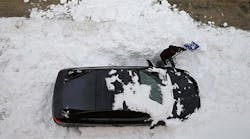Winter Storm Jonas left its fingerprints across the crinkled pages of the East Coast history book as one of the most prolific snow-producing weather events of recorded time. In its wake, there was more than a story or two about courage, survival, fortitude, determination, compassion and leadership.
One of those stories is this one: a tale about two feuding neighbors offered an opportunity to demonstrate how leadership in action extends beyond the workplace.
It is early morning in the Mid-Atlantic states, the Sunday after Winter Storm Jonas unleashed its wrath with thirty or more inches of snow and fifty mph wind gusts.
The scenery now is uniformly brushed in the color of snow, as if reminded by nature that we are all in this together: one world, one place.
The calm after the storm quickly yields to the impending activity of the day: snow removal.
There are two neighbors, each after their own cause, each looking to remove enough snow to clear a path for their vehicle.
Their parking spaces share the same corner. This is all they apparently have in common. Their vehicles, at ninety degrees to each other, are entombed by the aftermath of Jonas.
There is no room in the small parking lot to place the snow other than on the center median where most of the other residents are placing the snow.
One neighbor manages a head start, shovel in hand, gloves, glasses, heavy jacket, boots, warm pants and hat on.
After about four hours, the first neighbor clears two narrow paths for his truck tires to pass.
He shaves down the snow barely enough between these two paths so his vehicle can clear it.
The job is done, in his mind. All set. Time for some hot chocolate and marshmallows.
His neighbor follows and does the same thing except doesn’t move the snow to the center median. Instead, the second neighbor shovels the snow back into the same area the first neighbor just cleared. The snow pile reappeared.
You guess it. Out comes the first neighbor. The argument between the two nears the brink of an altercation.
As they both talk over each other, neither notices a small-framed elderly woman shoveling her area four parking spots down.
Minding her own business, she moves her snow pile to the median bit by bit. She works feverishly, seemingly to avoid the verbal dispute between her two neighbors.
Common Cause Realization
Just then, a shovel-toting stranger approaches and notices the two neighbors in conflict and the elderly woman laboring to shovel her snow.
Decision point: Should this stranger simply walk by and mind his own business? Should he help the elderly woman? Should he intervene to break up the dueling neighbors? If so, how? Should he demonstrate leadership?
The stranger elected to use the power of common cause realization, influence and leadership in action to diffuse the situation. This is how he did it:
- He walked by the two arguing neighbors, smiled and nodded to acknowledge their presence.
- He proceeded over to the elderly woman and took over where she left off. The stranger only had to remove one shovel full of snow. That was all she had left to do. Her smile was precious in appreciation for the helping hand.
- He, then, without saying a word, walked over to the two squabbling neighbors and proceeded to dig out their parking spots. He takes the snow to the median, over and over again.
Now there is one.
Suddenly, the stranger notices a shadow flash by to his left. The elderly woman decided she wanted to help. She too digs and digs and takes the snow to the median, over and over again.
Now there are two.
The rivaling neighbors, baffled at first, replaced the act of arguing with the action of digging and digging and moving snow to the median, over and over again.
Now there are four.
No words were exchanged between these individuals until after the job was done, forty five minutes later.
By the end, everyone was out of breath but the feeling of accomplishment was in the brisk air. Enough snow now is removed from each of their assigned parking areas to allow passage.
So what just happened?
A stranger recognized an opportunity to make a difference. The conflict driver was the snow. No snow, no conflict.
He accepted the challenge to demonstrate that if people come together for a recognized common cause, anything is possible; that positive action and compassion is contagious; that elevated emotions can be defused by engaging and demonstrating focus towards mission accomplishment and that leadership is not something you implement only at work, it is a lifestyle.
When it comes to leadership, it is better to show rather than to tell. Find the conflict drivers and remove them.
This special moment now is a fingerprint in the crinkled pages of my memory book.
I distinctively can remember the grateful look in their eyes as we all realized that something special had transpired that faithful day…one lesson in leadership, one snow shovel full at a time.
